Vascular Access Use Among Hemodialysis Patients and Competency of Nurses at National Kidney Centre, Nepal
DOI:
https://doi.org/10.3126/nmj.v3i2.34111Keywords:
Arteriovenous fi stula; Central venous catheter; Nurse; Renal dialysisAbstract
Introduction: Vascular access are a prerequisite for hemodialysis and good care by nurses is key to their longevity. A pattern of vascular access use has not been assessed previously nor the competency of nurses to identify the gaps in knowledge and skills. This study aims to describe vascular access use and nursing competency at National Kidney Centre.
Materials and Methods: A cross-sectional study was done to obtain demographic information and history of vascular access of patients. Vascular access was examined. Demographic and professional information of nurses were collected. A quiz based on KDOQI Clinical Practice Guidelines and a visual analogue scale to indicate confidence in managing vascular access were administered to the nurses.
Results: Four-hundred seventy-two patients and 70 nurses were recruited. The proportion of patients with an arteriovenous fistula, arteriovenous graft, tunneled catheter, and non-tunneled catheter at the time of initiation of hemodialysis were 24.36%, 0.64%, 1.27%, and 73.73%, respectively, and after conversion was 67.23%, 5.08%, 1.98%, and 19.77%, respectively. The cost at initiation was lower for catheters and the arteriovenous access in long run. Nurses had received vascular access training during their hemodialysis course (95.71%), but a few received further training (38.57%). They did well in sections related to preparation for permanent access and treatment of complications.
Conclusions: Most of the patients initiated hemodialysis via a non-tunneled catheter. The prevalence of arteriovenous fistula was high. Continued training of nurses was lacking. Nurses were confident in managing arteriovenous fistula and non-tunneled catheters.
Downloads
Downloads
Published
How to Cite
Issue
Section
License
Copyright (c) 2020 Nabin Bahadur Basnet, Jeena Shrestha, Sangita Raj Ghatani, Subhadra Regmi, Shrijana Bhandari, Rishi Kumar Kafle

This work is licensed under a Creative Commons Attribution 4.0 International License.
This license enables reusers to distribute, remix, adapt, and build upon the material in any medium or format, so long as attribution is given to the creator. The license allows for commercial use.
Copyright on any article published by Nepalese Medical Journal is retained by the author(s).
Authors grant Nepalese Medical Journal a license to publish the article and identify itself as the original publisher.
Authors also grant any third party the right to use the article freely as long as its integrity is maintained and its original authors, citation details and publisher are identified.




